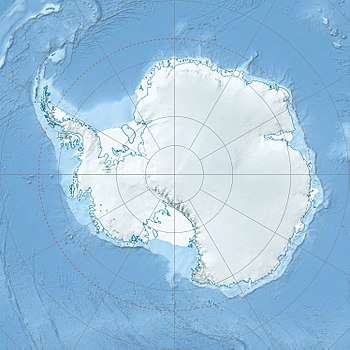Brown Bluff
Brown Bluff is a basalt tuya on the Tabarin Peninsula of northern Antarctica.[2] It formed in the past 1 million years, which erupted subglacially within an englacial lake. The volcano's original diameter is thought to have been about 12–15 kilometers (7.5–9.3 mi) and probably formed by a single vent. Brown Bluff is divided into four stages: pillow volcano, tuff cone, slope failure, and hyaloclastite delta; and into five structural units.[3]
| Brown Bluff | |
|---|---|
Brown Bluff as seen from Antarctic Sound | |
| Highest point | |
| Elevation | 745 m (2,444 ft) [1] |
| Coordinates | 63°32′S 56°55′W [1] |
| Geography | |
 Brown Bluff | |
| Geology | |
| Mountain type | Tuya |
| Volcanic field | James Ross Island Volcanic Group |
| Last eruption | Pleistocene |
The volcano gets its name from its steep slopes and brown-to-black hyaloclastite. It was applied by the Falklands Islands Dependencies Survey following their survey in 1946.[1]
Environment
Topography
Brown Bluff has a 1.5 km-long (0.93 mi) cobble and ash beach rising increasingly steeply towards towering red-brown tuff cliffs embedded with bombs and tephra. The cliffs are heavily eroded, resulting in loose scree and rock falls on higher slopes, and large, wind-eroded boulders on the beach. Permanent ice and tidewater glaciers surround the site to the north and south, occasionally filling the beach with brash ice.
Flora and fauna
Lichens in the genera Xanthoria and Caloplaca have been recorded on exposed boulders from the shoreline to an elevation of 185 m (607 ft). Mosses occur at higher elevations near glacial drainage.
The site has been identified as an Important Bird Area (IBA) by BirdLife International because it supports a breeding colony of about 20,000 pairs of adelie, as well as about 550 pairs of gentoos. Other birds nesting there include Cape petrels, Wilson's storm petrels and kelp gulls.[4] Weddell seals regularly haul out, and leopard seals often hunt offshore.
Geology
Brown Bluff is a one-half-mile-high (0.80 km) cliff of volcanic rocks consisting of a tuya or moberg, which is a volcano erupted under an icecap. The base layer is breccia formed by violent phreatic eruptions under the lake formed in the ice cap by the magmatic heat. The middle yellow layers are palagonite weathering of steeply dipping ash layers. The top caprock is composed of black layers are basalt flows that erupted after the meltwater lake drained away, resulting in subaerial lava flows.[5]
See also
References
-

- Elias, Scott A.; Mock, Cary J. (2013). "Encyclopedia of Quaternary Science". Elsevier. Cite journal requires
|journal=(help) - Skilling, I. P. (1994) Evolution of an englacial volcano: Brown Bluff, Antarctica, Bulletin of Volcanology, Volume 56, Issue 6-7, pages 573-591. Retrieved on 2007-11-11
- "Brown Bluff". BirdLife data zone: Important Bird Areas. BirdLife International. 2012. Archived from the original on 2007-07-10. Retrieved 2012-12-10.
- Joseph Holliday, Earth Science Department, El Camino College
External links
| Wikimedia Commons has media related to Brown Bluff. |
- Secretariat of the Antarctic Treaty Visitor Guidelines and site description
- "Antarctic Treaty Visitor Guidelines, Brown Bluff" (PDF). Archived from the original (PDF) on 2007-10-11. Retrieved 2011-03-13.